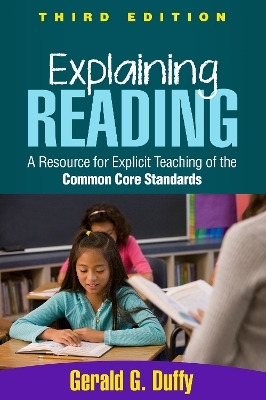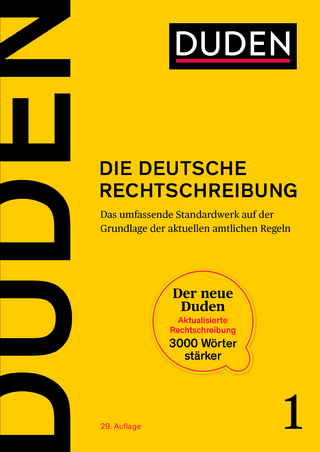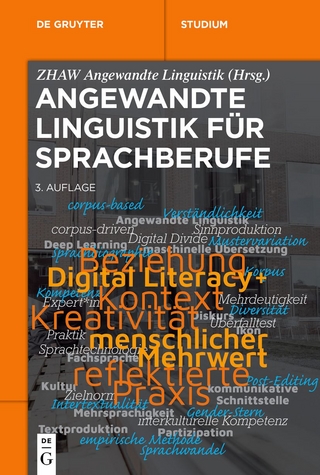
Explaining Reading, Third Edition
Guilford Press (Verlag)
978-1-4625-1556-1 (ISBN)
This trusted teacher resource and widely adopted text presents effective ways to demystify essential reading skills and strategies for K-8 students who are struggling. It has been fully revised to focus on the Common Core State Standards (CCSS) for English language arts. Following a concise introduction to the CCSS and explicit teaching, 30 engaging examples show how to be explicit when teaching each Literature, Informational Text, and Foundational Skills standard. Grounded in authentic reading tasks that teachers can adapt for their classrooms, the examples guide teachers to differentiate instruction, model and scaffold learning, assess student skills, and align reading instruction with Common Core writing standards.
New to This Edition
*Significantly revised and restructured with a CCSS focus.
*The teaching examples are all new or revised.
*Provides practical ways to develop "close reading" of text.
*Incorporates recent research on authentic tasks and adaptive teaching
Gerald G. Duffy, EdD, is the former William Moran Distinguished Professor of Literacy and Reading at the University of North Carolina at Greensboro and Professor Emeritus at Michigan State University. Now retired and living in Deer Park, Washington, he was an elementary and middle school teacher, researcher, and teacher educator for over 50 years. His teaching and research focused on the explicit teaching of reading, on comprehension, and on the development of adaptive teachers. A past president of the National Reading Conference (now the Literacy Research Association) and a member of the Reading Hall of Fame, Dr. Duffy has worked with teachers and children across the United States and overseas. He has written and edited several books on reading instruction and has published over 150 articles and research studies.
I. Introduction
1. Five Foundational Principles
2. How Comprehension and Foundational Skills Work
3. Emphasizing Large Ideas as Well as the Nitty-Gritty
4. How to Use Part II of This Book
5. Professional Judgment and Teaching to Standards
II. The Teaching Examples
Examples for Explaining Literature
Example 1. Reading for Key Details (Key Ideas and Details--RL Standard 1)
Example 2. Drawing Inferences (Key Ideas and Details--RL Standard 1)
Example 3. Theme (Key Ideas and Details--RL Standard 2)
Example 4. Character Traits and Motivations (Key Ideas and Details--RL Standard 3)
Example 5. Descriptive Words and Phrases (Craft and Structure--RL Standard 4)
Example 6. Text Types (Craft and Structure--RL Standard 5)
Example 7. Story Structure (Craft and Structure--RL Standard 5)
Example 8. Point of View (Craft and Structure--RL Standard 6)
Example 9. Illustrations and Text Meaning (Integration of Knowledge and Ideas--RL Standard 7)
Example 10. Compare--Contrast (Integration of Knowledge and Ideas--RL Standard 9)
Examples for Explaining Informational Text
Example 11. Main Idea (Key Ideas and Details--RI Standard 2)
Example 12. Making Connections and Establishing Relationships (Key Ideas and Details--RI Standard 3)
Example 13. Word Meaning (Craft and Structure--RI Standard 4)
Example 14. Using Context Clues to Determine Word Meaning (Craft and Structure--RI Standard 4)
Example 15. Text Features (Craft and Structure--RI Standard 5)
Example 16. Text Structure (Craft and Structure--RI Standard 5)
Example 17. Analyzing Positions and Views (Craft and Structure--RI Standard 6)
Example 18. Using Graphic Information (Integrating Knowledge and Ideas--RI Standard 7)
Example 19. Evaluating Supportive Evidence (Integrating Knowledge and Ideas--RI Standard 8)
Example 20. Synthesizing (Integrating Knowledge and Ideas--RI Standard 9)
Examples for Explaining Foundational Skills
Example 21. Front--Back/Left--Right/Top--Bottom (Print Concepts--RF Standard 1)
Example 22. Print Detail (Print Concepts--RF Standard 1)
Example 23. Discriminating among Sounds (Phonological Awareness--RF Standard 2)
Example 24. Letter--Sound Association (Phonics and Word Recognition--RF Standard 3)
Example 25. Vowel Patterns (Phonics and Word Recognition--RF Standard 3)
Example 26. Syllabication (Phonics and Word Recognition--RF Standard 3)
Example 27. Sight-Word Recognition (Phonics and Word Recognition--RF Standard 3)
Example 28. Structural Analysis (Phonics and Word Recognition--RF Standard 3)
Example 29. Reading with Expression (Fluency--RF Standard 4)
Example 30. Quick Recognition of Easily Confused Words (Fluency--RF Standard 4)
Appendix. Research Foundations for This Book
| Erscheint lt. Verlag | 14.7.2014 |
|---|---|
| Verlagsort | New York |
| Sprache | englisch |
| Maße | 152 x 229 mm |
| Gewicht | 380 g |
| Themenwelt | Schulbuch / Wörterbuch ► Erwachsenenbildung |
| Geisteswissenschaften ► Sprach- / Literaturwissenschaft ► Sprachwissenschaft | |
| Sozialwissenschaften ► Pädagogik ► Schulpädagogik / Grundschule | |
| ISBN-10 | 1-4625-1556-8 / 1462515568 |
| ISBN-13 | 978-1-4625-1556-1 / 9781462515561 |
| Zustand | Neuware |
| Informationen gemäß Produktsicherheitsverordnung (GPSR) | |
| Haben Sie eine Frage zum Produkt? |
aus dem Bereich


